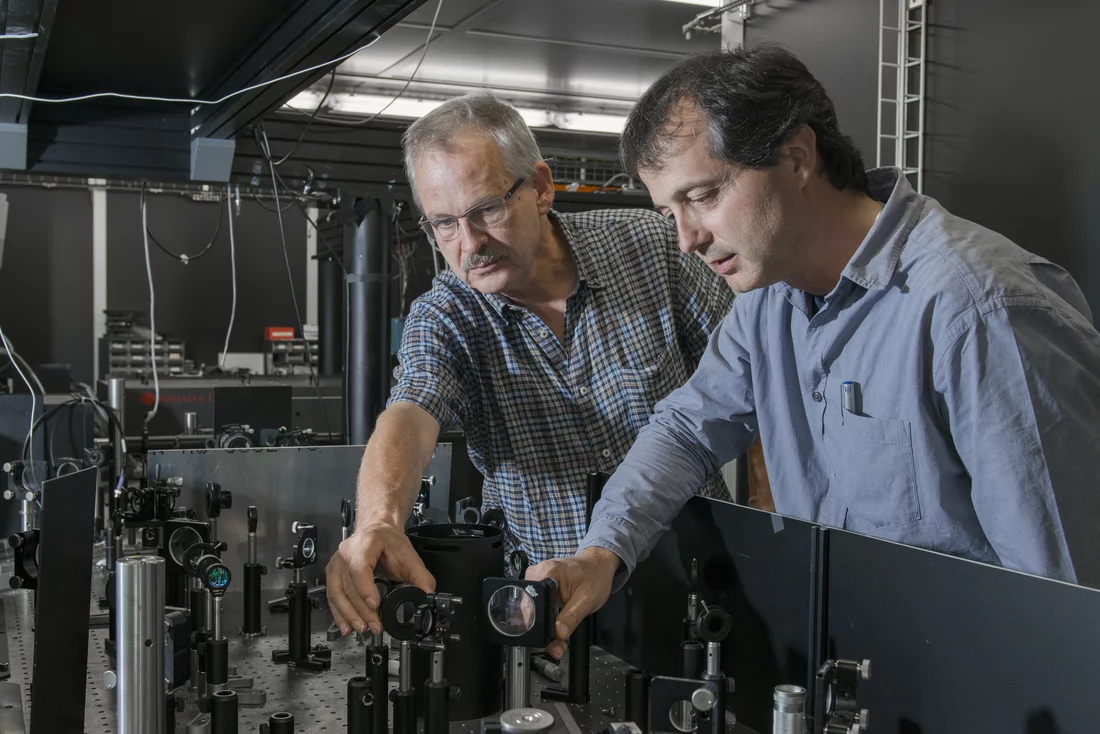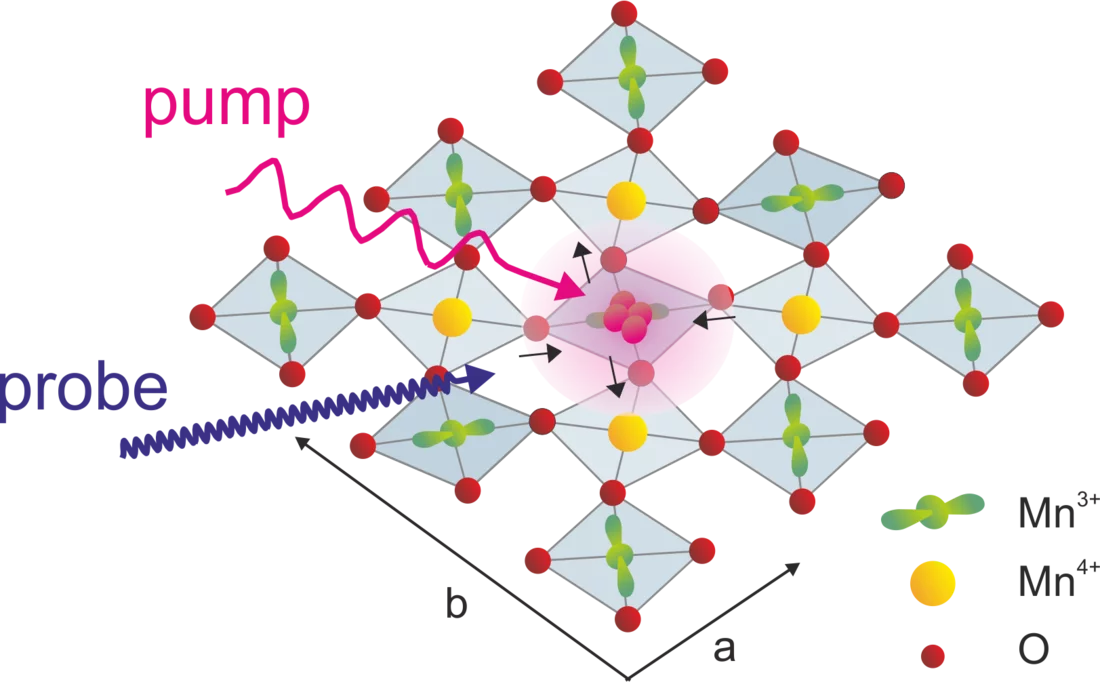PSI researchers garner experience for SwissFEL experiments
Aided by short laser flashes, researchers at the Paul Scherrer Institute have managed to temporarily change a material’s properties to such a degree that they have – to a certain extent –created a new material. To monitor these changes, they used very short flashes of x-rays generated by the x-ray laser, LCLS, in California. With these x-ray flashes they scanned the material and gained insight that could help in the development of materials for more high-performance electronic devices. Experiments like the ones with LCLS will be possible at PSI with the entry into service of the x-ray laser SwissFEL at the end of 2016. For researchers at PSI, the studies in the USA are an opportunity to gain experience that can then be used in setting up the experimental workstations at SwissFEL.
At present, only two such x-ray lasers exist in the world. To conduct experiments there, researchers must apply for time to do so, and successfully compete with many others from around the globe. PSI researchers have already carried out diverse experiments in both facilities. They also benefit from the experience gained at the Swiss Light Source (SLS) at PSI. While the SLS is not an x-ray laser, it can generate very short, albeit much weaker, flashes of x-ray light. Some more simple experiments similar to those with an x-ray laser can be conducted at the SLS.
New material generated for just a short time
Materials can have very different properties. For instance, some are good electrical conductors, whilst others are good insulators, some are magnetic, others aren’t. These properties are determined by the behaviour of the particles from which the material is made, and in some cases, by how electrons are arranged inside the material, and whether or not they can move. If you change the electrons’ freedom of movement, you can also change the material’s properties. In co-operation with scientists at ETH Zurich, the University of Tokyo and the research lab SLAC in Stanford (California), PSI researchers conducted an experiment on the material Pr0.5Ca0.5MnO3, where additional energy was injected into electrons with the help of a very short laser pulse. Electrons, which were almost all firmly bound to specific atoms, were then able to skip from atom to atom. The material transformed to a certain extent from an isolator into a metal. We practically created a new material which doesn’t occur in this form in nature
, explains Urs Staub, a physicist at PSI. This material, i.e. this new state, only exists for a very, very short period of time. But there is still enough time to investigate its properties.
Short exposure time on the x-ray laser
The new state was investigated using the x-ray laser LCLS which is operated by SLAC in California. LCLS generates very short and very intense flashes of x-ray light which reveal the processes inside a material. As this state changes fast, it is important that the flashes are short, to ensure the images don’t wobble
. The researchers have repeated the experiment several times varying the time interval between the laser and the x-ray pulse. In this way they can determine how the inner state of the material is modified on an ultrafast time scale.
Understanding the materials
The material investigated has a similar structure to materials which could be of importance for electronic devices, because they manifest what is known as colossal magnetoresistance. This effect leads to major changes in the material’s electrical resistance when it is near a magnet. This could be important, for instance, during readout of magnetic memories. The results help us gain a fundamental understanding of how materials of this kind behave
, explains Paul Beaud, physicist at PSI, who conducted the experiment together with Staub. In this way a material’s properties can be modified in a specific manner to develop new materials.
PSI researchers prepare for the large research project SwissFEL
PSI researchers have already conducted numerous experiments with the x-ray lasers LCLS in the USA and SACLA in Japan. Like the large research PSI facilities, these facilities are open to external researchers who can apply for experiment time there. The competition is tough – only the most interesting and promising projects make the cut. They have confidence in us because we have already been conducting successful experiments of this kind at the SLS for some time now
, stresses Staub. PSI’s Swiss Light Source is not an x-ray laser but it does produce intensive x-ray light from which very short flashes can be generated using special techniques. This means that experiments can be carried out which, in principle, are very similar to those using the x-ray laser. Nonetheless, an x-ray laser opens up completely new opportunities for specific experiments. It permits the investigation of processes which were not accessible to previous methods, mainly because the light of the x-ray laser is far more intense and in shorter pulses. That’s why PSI is building its own x-ray laser, SwissFEL, which is scheduled to enter service at the end of 2016. Beaud and his colleague Gerhard Ingold, who were involved in constructing and operating the ultra-short x-ray source at the SLS, are now developing an experimental station for SwissFEL to investigate fast processes in solid-state physics. For this project the experience gained in the USA and in Japan is of immeasurable value
, comments Beaud.
Text: Paul Scherrer Institut/Paul Piwnicki
About PSI
The Paul Scherrer Institute PSI develops, builds and operates large, complex research facilities and makes them available to the national and international research community. The institute's own key research priorities are in the fields of matter and materials, energy and environment and human health. PSI is committed to the training of future generations. Therefore about one quarter of our staff are post-docs, post-graduates or apprentices. Altogether PSI employs 1900 people, thus being the largest research institute in Switzerland. The annual budget amounts to approximately CHF 350 million.
Contact
Dr Paul Beaud; FEMTO research groupPaul Scherrer Institute; 5232 Villigen PSI; Schweiz
Tel.: +41 56 310 41 21; Email: paul.beaud@psi.ch
Dr Urs Staub; Microscopy and magnetism research group;
Paul Scherrer Institute; 5232 Villigen PSI; Switzerland Tel.: +41 56 310 44 94; E-Mail: urs.staub@psi.ch
Original Publication
A time-dependent order parameter for ultrafast photoinduced phase transitionsP. Beaud et al.
Nature Materials; doi:10.1038/nmat4046 (published online 3 August 2014)
Detailed presentation for particularly interested people
The material examined, Pr0.5Ca0.5MnO3 (PCMO), has a perovskite structure and belongs to a larger class of materials in which colossal magnetoresistance can be observed. What is common to the materials in this class is that their properties are modified by the interaction between several degrees of freedom.
For example, in the material examined there is a link between the charge order and the lattice structure, i.e. the arrangement of the atoms. In the material’s basic state, manganese ions (Mn) can occur in three different forms, depending on how their electrons behave. Half of the ions have a 4+ charge, causing the spatial distribution of the outer electrons to be almost spherical. The other ions are in a 3+ state, in which the additional electron remains in a longitudinal orbital. The 4+ and 3+ manganese ions are evenly distributed over the structure and form a superlattice with a two-fold and four-fold grid distance of the perovskite structure. At the same time, the overall lattice is slightly distorted compared with an ideal structure – the result of the link between the charge order and lattice structure. If you illuminate the material with a sufficiently strong laser pulse (experts call this pulse a
pump), the outer electrons in the orbitals of the manganese ions are excited and they can move between the atoms. This leads to the disappearance of the regular arrangement of the different manganese ions. This transition phase goes hand in hand with a change in the order of the atomic lattice. After only a brief moment, the distortion of the atomic lattice disappears.
Using extremely short pulses (these pulses are called
probes) from the x-ray laser LCLS, the researchers were able to observe these changes, which happen in a fraction of a picosecond. They conducted scattering experiments on these materials with these probes. The additional lattices create additional scattering reflections thanks to the different lattice spacing. These reflections disappear as soon as the charge order, formed by the different orbitals, disappears. As the probe-x-ray pumps are extremely short, the researchers were able to determine the strength of the reflections for various times between the pump and the probe and observe how the charge order dissolves over the course of time. By observing other reflections you can see how the distortion of the structure disappears.
Only with x-ray light it is possible, at the same time, to measure the electronic and atomic order and its dynamics on an ultrafast time scale, stresses Staub.
This experiment helps to elucidate the processes in the entire material class. Beaud,
On the basis of our experiment we were able to develop a theoretical concept which offers a good description of the dynamic interaction between the electrons and the atomic lattice in a state of non-equilibrium. We believe that it can be applied to an entire class of problems.


